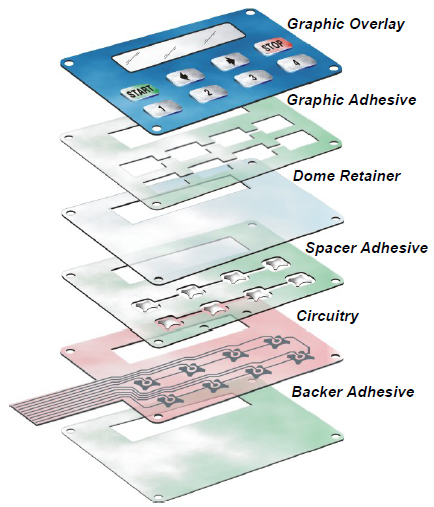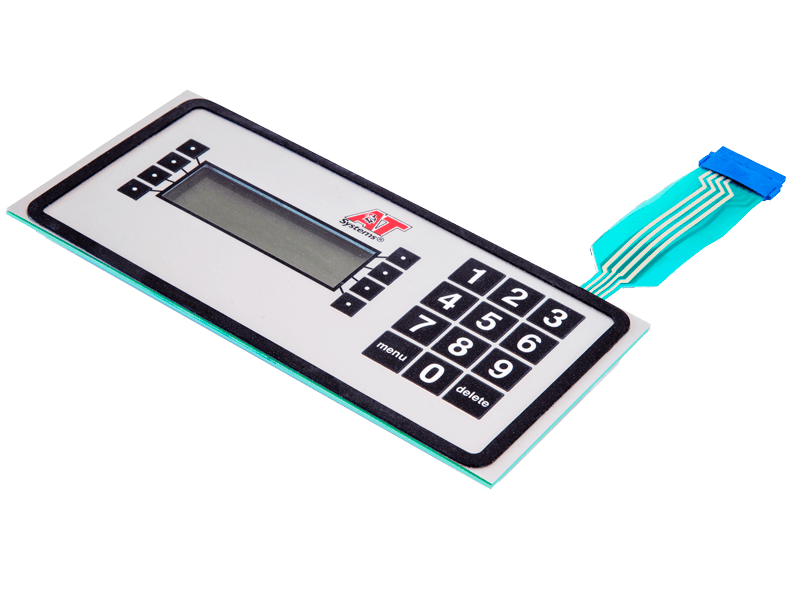When tailored design needs arise, a specialized membrane switch manufacturer is the top choice.
When tailored design needs arise, a specialized membrane switch manufacturer is the top choice.
Blog Article
Everything About Membrane Layer Switch Over: Recognizing Its Design and Functionality
When you consider the control interfaces in modern-day tools, membrane buttons typically come to mind. These components are much more than just switches; they blend style and functionality effortlessly. Recognizing exactly how they function and what makes them effective can change your perspective on day-to-day electronics. There are nuances to their design and performance that you might not be aware of. Allow's explore what collections membrane changes besides various other control systems.
What Are Membrane Layer Switches?

Their seamless nature makes them easy to tidy and immune to dust and moisture, a vital feature in many atmospheres. Membrane buttons can likewise be customized regarding form, size, and graphics, enabling suppliers to create distinct interfaces tailored to certain products. Plus, they're light-weight and thin, which helps in lessening the general mass of gadgets. On the whole, membrane switches play a considerable function in boosting individual experience across a wide range of applications.
Exactly How Membrane Layer Switches Work
When you push a key on a membrane switch, it turns on an uncomplicated yet efficient device. membrane switch manufacturer. The leading layer, commonly made of flexible product, pushes down onto a conductive layer under it.
You'll see that the responsive responses varies based upon the switch style, providing either a soft click or a more obvious reaction. Once you release the secret, the membrane layer returns to its initial position, resuming the circuit and quiting the signal. This procedure takes place almost immediately, making sure a responsive customer experience.
Membrane buttons are popular due to their longevity and resistance to dirt and wetness, making them ideal for various applications, from home home appliances to clinical tools. Understanding this operation assists you value their prevalent use.
Key Elements of Membrane Layer Switches
Comprehending the essential elements of membrane buttons is essential for understanding their capability and layout. At the core, you'll discover the visuals overlay, which supplies the aesthetic interface for users. Underneath that, there's a spacer layer that separates the circuit layers, making sure that they don't make contact till pressed. The circuit layer is where the magic takes place; it contains conductive traces that finish the circuit when you push the button. Another crucial component is the sticky support, enabling the switch to abide by surfaces securely. The protective layer shields against environmental aspects and use, extending the switch's life-span. Each part plays a significant function in guaranteeing trustworthy performance and individual interaction. By understanding these elements, you'll get insight into exactly how membrane layer switches operate and their value in various applications.
Materials Utilized in Membrane Change Design
The efficiency and resilience of membrane layer switches over greatly depend on the products made use of in their style. You typically run into polyester and polycarbonate as main substratums as a result of their exceptional stamina and adaptability. These products resist scratches and chemicals, making them optimal for demanding environments.
The conductive layers often use silver or carbon, picked for their dependability and conductivity. membrane switch manufacturer. Silver provides superior efficiency, while carbon is an affordable choice. For the overlay, you could think about a matte or glossy surface, depending upon your visual demands and user experience
Adhesives play a necessary function too; they bond layers safely and guarantee long life. Make sure to pick adhesives that stand up to ecological aspects like temperature level and moisture. Finally, do not neglect the significance of a great printing method for graphics, as it enhances both performance and visual appeal. Selecting the ideal products will ensure your membrane layer switch stands the test of time.
Style Considerations for Membrane Layer Switches
While developing membrane switches, it's important to take right into account various variables that influence their performance and user experience. Beginning by concentrating on the format and switch dimension; make specific they're user-friendly and easy to navigate.
Verify your layout suits environmental elements, like moisture or temperature level variants, which could influence performance. By meticulously considering these aspects, you'll create a membrane layer switch that enhances functionality and contentment.
Applications of Membrane Buttons
Membrane switches are versatile components found in various applications, from commercial tools to consumer electronics. You'll see their influence in machines that need resilient user interfaces and in devices that benefit from sleek designs. Recognizing these applications helps you value the performance and functionality of membrane layer switches in everyday modern technology.
Industrial Devices Usage
When you're looking to enhance the performance of commercial devices, membrane layer buttons use a reputable option that incorporates sturdiness with user-friendly layout. These switches are perfect for rough settings, supplying resistance to dirt, wetness, and chemicals. Embrace membrane buttons to enhance your procedures and improve overall efficiency.
Customer Electronic Devices Integration
In the domain of consumer electronic devices, membrane buttons play a crucial duty in improving customer interaction see here now and device performance. Membrane switches additionally Website ensure toughness and resistance to dust and dampness, extending the life expectancy of your electronics. By choosing membrane buttons, you enhance not simply the performance but likewise the style of your gadgets, making daily communications smooth and satisfying.
Benefits and Drawbacks of Membrane Layer Switches
While membrane buttons supply a variety of benefits, they additionally include some disadvantages that you should consider. One considerable benefit is their portable layout, making them ideal for space-constrained applications. They're likewise economical, providing a long lasting remedy with a reduced manufacturing expense. Furthermore, their seamless surface area is easy to tidy, enhancing hygiene in environments like healthcare facilities.

Membrane layer switches can have a much shorter life expectancy contrasted to mechanical switches, specifically under heavy use. They can likewise be much less tactile, which may impact user responses throughout operation. Stabilizing these pros and disadvantages will help you identify if membrane switches are the right fit for your project.
Frequently Asked Questions
Just How Long Do Membrane Changes Generally Last?
Membrane changes typically last between 5 to ten years, relying on use and ecological problems. You'll desire to examine variables like wear, direct exposure to dampness, and temperature variations to determine their long life successfully.
Can Membrane Switches Be Customized for Details Designs?
Yes, you can customize membrane buttons to fit certain layouts (membrane switch manufacturer). You'll have the freedom to pick shades, shapes, and formats that match your project's demands, ensuring they blend flawlessly with your total visual
What Is the Expense Variety for Membrane Layer Switch Manufacturing?
The price variety for membrane layer switch production generally drops between $1 additional reading and $10 each, depending upon factors like design intricacy, quantity, and products. You can obtain quotes from manufacturers to discover the most effective alternative.

Are Membrane Switches Over Water-proof or Resistant?
Membrane switches can be designed to be water-proof or immune, relying on materials used and building approaches. If you require them for wet settings, ensure you define those needs during the layout process.
Just How Do Membrane Layer Switches Over Contrast to Standard Switches?
Membrane buttons are normally thinner and more versatile than traditional switches, offering a smooth layout. They're usually easier to clean and incorporate, but might not offer the responsive feedback you're made use of to with mechanical alternatives.
Verdict

Report this page